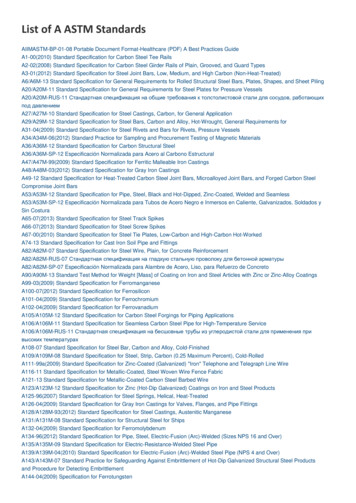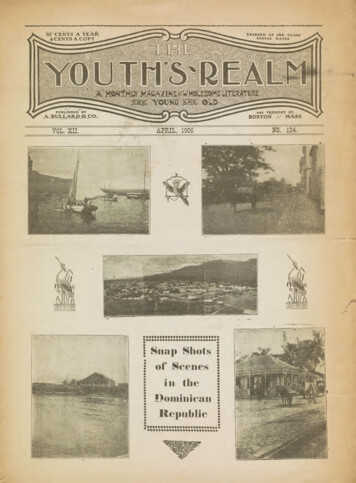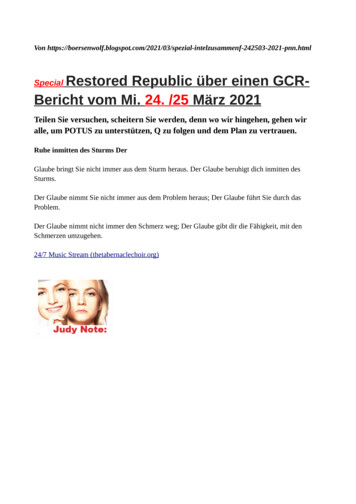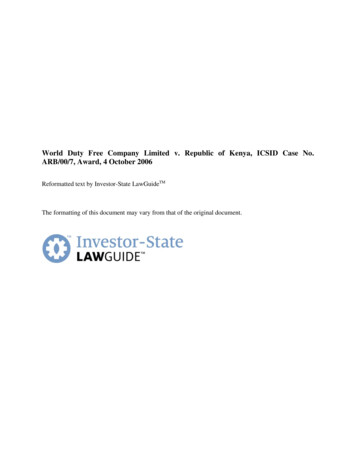
Transcription
THIS REPORT CONTAINS ASSESSMENTS OF COMMODITY AND TRADE ISSUESMADE BY USDA STAFF AND NOT NECESSARILY STATEMENTS OF OFFICIAL U.S.GOVERNMENT POLICYRequired Report - public distributionDate: 12/30/2009Dominican RepublicEXPORTER GUIDE ANNUALApproved By:Margie Bauer, Agricultural AttachéPrepared By:Wagner Mendez, Marketing SpecialistReport Highlights:The Dominican Republic is the third largest market for high value products in the WesternHemisphere, right after Canada and Mexico. The CAFTA-DR agreement has strengthened thecompetitive position of the United States in the Dominican market. In addition, the agreement hascontributed to improving the legal framework that regulates the relationship between U.S.suppliers and Dominican importers.Post: Santo Domingo
TABLE OF CONTENTSPagesI.MARKET OVERVIEW . . . .3A. Current Economic Situation . .3B. Demographics and Income Distribution . .4C. Market Size . . . 5D. Advantages and Challenges in the Market . . .6II.EXPORTER’S BUSINESS TIPS . . .7A. Business Customs . .7B. Consumer Tastes and Preferences . .7C. Food Standards and Regulations . .7D. General Import and Inspection Procedures .81. Product Registration . .82. Customs Clearance .83. Tariff . .9E.Opportunities and Challenges after the Implementationof the CAFTA-DR . .9III.MARKET SECTOR STRUCTURE AND TRENDS. . .10A. Retail Food Sector . . 10B. Hotel, Restaurants and Institutions . 12C. The Food Processing Sector 12IV.BEST PRODUCT PROSPECTS . .13V.KEY CONTACTS AND FURTHER INFORMATION . 17APPENDIXESAPPENDIX I. STATISTICS . . 20Table A.Table B.Table C.Key Trade and Demographic Information .20Consumer Food & Edible Fishery Product Import .21Top 15 Suppliers Consumer Food & Edible FisheryProduct Import .22APPENDIX II. SELECTED INFORMATION ON THE CAFTA-DR . 23DISCLAIMER: The Office of Agricultural Affairs of the United States Department of Agriculture in SantoDomingo, Dominican Republic, prepared this report for U.S. exporters of food and agricultural products.While the AgOffice took every possible care in preparing this report, the information provided may not becompletely accurate either because policies have changed since its preparation, or because clear andconsistent information about these policies was not available. It is highly recommended that U.S. exportersverify the full set of import requirements with their foreign customers, who are normally best equipped toresearch such matters with local authorities, before shipping any product.FINAL IMPORT APPROVAL OF ANY PRODUCT IS SUBJECT TO THE IMPORTING COUNTRY’S RULESAND REGULATIONS AS INTERPRETED BY BORDER OFFICIALSAT THE TIME OF PRODUCT ENTRY.2
I.MARKET OVERVIEWIn spite of the current global financial crisis and its effects on the Dominican economy, the foodsector continues with its dynamic growth. Dominican food importers continue to look for new U.S.products. Major supermarket chains are increasing their number of stores to cover other regions ofthe country or other sectors of major cities.The Dominican Republic continues to be the third largest market for high value products from theUnited States in the Western Hemisphere. Because of the implementation of the CAFTA-DR, thecompetitive position of the country is strengthening.A.Current Economic SituationIn spite of the global economic crisis, the DR’s GDP continues to grow, although slower than in2008. The main drivers of growth in the D.R. are investment, agriculture, tourism,communications, construction, andGDP CONTINUES TO GROW IN THE D.R. AFTERremittances. Of course, a strongerU.S.WORLDWIDE RECESSIONperformance will lift GDP growth.TheUnited States is maintaining itsstrong competitive position in the8.5010.00market for high value products. In5.808.004.50addition, business people in thefood6.00%2.50sector are showing their optimismby1.504.00investing in building new stores and2.00warehouses.0.00Growth of GDP in January to June1.4%. The Economist Intelligence(EIU) forecasts that this willcontinue to rise in the second halfthe year to 1.5% and reach 2.5% in2010.According to the EIU, although theannual inflation was negative in thefirst part of 2009, it will end theyear at 5% because of higher oilprices. It is expected to average5.6% in 2010.The Dominican peso is expected todepreciate 2.5% compared to theU.S. dollar in 2009, declining fromits mid-August level of DR 36 toUS 1 to just under DR 37 to US 1by the end of 2009 and DR38.6 toUS 1 by the end of 2010.B. ce: Central Bank of the Dominican Republic and theEconomist Intelligence Unit.* Data for 2009 and 2010 is a forecast made by theEconomist Intelligence Unit.ofINFLATION RATE IN THE D.R. WILL REMAIN STABLEIN 2009 AND 00720082009*2010*YEARSSource: Central Bank of the Dominican Republic and theEconomist Intelligence Unit.* Data for 2008 and 2009 is a forecast made by theEconomist Intelligence Unit.3and
Income DistributionThe target for U.S. high value products are middle and upper income consumers. Middle and upperincome consumers, a total of 4.2 million people, shop regularly at supermarkets, eat inrestaurants, and vacation in resorts. Luxury goods are purchased by the upper and upper middleincome classes, with a total population of about 2.2 million people. The lower income class canafford to buy basic U.S. food products, such as beans, poultry, oats, and bread.With the opening of the economy and the implementation of the CAFTA-DR, U.S. products aremore affordable by the lower income class. In addition, promotion strategies developed by majorsupermarket chains are increasing the number of lower income consumers who shop atsupermarkets.The Dominican National Statistics Office estimates the 2009 Dominican population at 9.8 millionpeople. About 6.2 million people or 63% of the population live in urban areas and 3.6 millionpeople or 37% of the population live in rural areas. With an estimated population growth of about1.8% per year, the Dominican Republic will have 10 million people by 2011 (Dominican NationalStatistics Office, 2009).With approximately 3.0 million people or 31% of the total population, the city of Santo Domingo(the National District, the Santo Domingo province and its surrounding suburbs) is the biggestmarket in the country. Santiago is the second largest market with one million people. Otherimportant cities are San Pedro de Macorís, La Romana, La Vega, Bonao, San Francisco de Macorís,and Higuey. The construction of new highways, seaports, and airports in recent years, includingthe road from Santo Domingo to Samana, and the well-developed telecommunicationsinfrastructure allow smooth distribution of products throughout the country.OVER FOUR MILLION PEOPLE IN THE D.R. CANAFFORD U.S. HIGH VALUE FOOD PRODUCTS)Upper Class588,0006%Upper e Class1,960,00020%Lower Class4,606,00047%Source: Built by FAS/Post with data from the Dominican National Statistics Office, 2009.4
C.Market SizeThe demand for food products in the Dominican is estimated at over 1.6 billion. It is alsoestimated that about 40% or 640 million of all food products consumed in the country areimported. The U.S. market share is estimated at 34% or 218 million of total imports in 2008.With the tariff advantage of the CAFTA-DR agreement, we estimate that our share will increase to40% or 256 million in 2009.Although data are not available to quantify the amount of imported products that go to thedifferent sectors in the Dominican Republic, we estimate that about 80% is distributed throughsupermarkets and mom ‘n pop stores. About 20% goes to the tourism industry; all-inclusiveresorts tend to source local food products to lower their costs.In addition to the demand for high value food products from the United States, the food processingsector has good potential for food and beverage ingredients and intermediate products for furtherprocessing. The AgOffice estimates that the DR food-processing sector imports over US 400million. The United States has about 50% market share.5
D.Advantages and Challenges in the MarketAdvantagesChallenges1. The implementation of theCAFTA-DR has lowered oreliminated duties for some U.S.food products.1. The Dominican Republic signed an EconomicPartnership Agreement with the EU and it isnegotiating free trade agreements with othercountries, such as Canada and Taiwan.2. Because of the CAFTA-DRagreement, U.S. products aremore competitive in the market.2. Tariff rate quotas of sensitive productscontinue to protect local producers ofproducts, such as meat, dairy products,beans, rice, and poultry.3. The tourism sector is large andgrowing, increasing the demandfor high value food products.4. Consumers are demanding higherquality and healthier products,and they perceive U.S. productsmeet their requirements.5. Food distribution channels arebecoming more efficient, whichfacilitates the flow of importedfood products.6. Dominicans are greatlyinfluenced by U.S. culture andhave a positive perception ofU.S. products.3. The local Dominican food industry is becomingmore efficient and more competitive, as itintegrates new technologies into its productionprocesses.4. Perceived sanitary and phytosanitarycontinue to limit U.S. exports.issues5. The Dominican Government requires Spanishlabeling on all pre-packaged food products.6. Globalization has allowed other regions, suchas Europe and South America, to expand salesinto the Dominican Republic, what hastraditionally been a U.S. dominated market.6
II.EXPORTER’S BUSINESS TIPSA.Business CustomsPersonal relationships are a key factor for doing business in the Dominican Republic. A commoncourtesy is to give a warm handshake combined with conversation about the person’s well-beingand his family prior to starting the business-related conversation. Dominicans are extremelyfriendly and prefer to develop a personal relationship before going into a business relationship.This relationship helps Dominican business people develop more confidence before makingbusiness commitments. However, as genuinely warm and friendly as Dominicans are, it isimportant that both parties have all aspects of the transaction in writing.U.S. exporters may enter the Dominican market through locally appointed distributors, their whollyowned subsidiary, joint ventures, or Dominican importers and wholesalers who also own retailoutlets. If market branding is important, we advise that U.S. suppliers have a local representativeor distributor in the Dominican Republic. Before signing an agreement with a distributor, pleaseread it carefully to avoid misunderstandings.It is important to note that the D.R. Law 173 requires U.S. suppliers to pay the distributorcompensation when a distributor agreement is broken. Even if the amount of compensation wasspecified in the agreement, importers could claim greater compensation under Law 173. With theimplementation of the CAFTA-DR agreement, the supplier and the distributor must abide by theamount of compensation in their agreement.B.Consumer Tastes and PreferencesDominicans have adopted a lot of U.S. culture, such as music, sports, and fashion. The foodconsumption trend in the Dominican Republic is similar to trends in the United States, althoughtrends may lag by ten to fifteen years.Dominican consumers perceive that products made in more developed countries, such as theUnited States, are more reliable in terms of quality and safety. Middle and high income classestend to consume more natural and healthy products. These consumers are demanding food withless saturated fat, cholesterol, and sugar.C.Food Standards and RegulationsPlease refer to the Dominican Food and Agriculture Import Regulations and Standards (FAIRS)Report for more detailed information, which can be found ions%20and%20Standards%20%20Narrative Santo%20Domingo Dominican%20Republic 7-22-2009.pdfAccording to the Dominican food labeling regulation for retail products, NORDOM 53, food productsmust provide the following information in Spanish:Company brandProduct nameProduct descriptionNet & dry weights (in international units, such as: kg, ml, etc.)List of ingredients and additives indicating the amounts used7
The name and address of the producer and importerProduct batch codeSanitation registration number(from the Department of Health)The expiration dateCountry of originInstructions for product useThis information may be on a sticker made by the manufacturer, the importer, or the retailer.NORDOM 53 is based on CODEX Alimentarius Standards. It requires labeling in Spanish and asanitary registration number. Although NORDOM 53 is not strictly enforced, the Norms andStandards Directorate (DIGENOR) of the Ministry of Industry and Commerce and the Ministry ofPublic Health (SESPAS) may remove improperly labeled products from the shelves. Multilinguallabels and stick labels are accepted.D.General Import and Inspection Procedures1.Product RegistrationIn principle, the first step in importing new food products into the Dominican Republic is productregistration. Importers register new high value food products with the Ministry of Public Health(SESPAS). SESPAS issues a certificate to the importer or the local legal representative with aSanitation Registration N
16.10.2009 · Dominicans have adopted a lot of U.S. culture, such as music, sports, and fashion. The food consumption trend in the Dominican Republic is similar to trends in the











